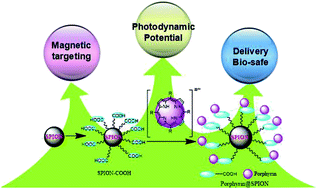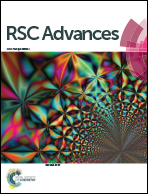Cationic porphyrin@SPION nanospheres as multifunctional anticancer therapeutics: magnetic targeting, photodynamic potential and bio-safety research†
Abstract
The synthesis and characterization of carboxyl-functionalized superparamagnetic iron oxide nanoparticles (SPION)-attached cationic porphyrins with different positive charges (porphyrin@SPION) are described as pH-sensitive, multifunctional photosensitization. These nanospheres exhibit excellent targeted cell accumulation under external magnetic field and outstanding cell photocytotoxicity in weak acidic solution, which is the pH for most tumors. The dicationic porphyrin@SPION has the smartest pH-responding release and lowest half-maximal inhibitory concentration (IC50) values after visible light irradiation against HeLa cells. Moreover, the delivery safety of these porphyrin@SPION nanospheres was considered by investigating their behaviors in human plasma during the delivery process. The results elucidate that these nanospheres have no significant deleterious influence on the frame conformation of protein in their delivery process and thus are relatively safe in the drug delivery process. Our study demonstrates that the combination of targeted magnetic-loading drug design methodology with the PDT potential of cationic porphyrins may be a very useful strategy to develop novel tumor-oriented multifunctional anticancer therapeutics.


 Please wait while we load your content...
Please wait while we load your content...